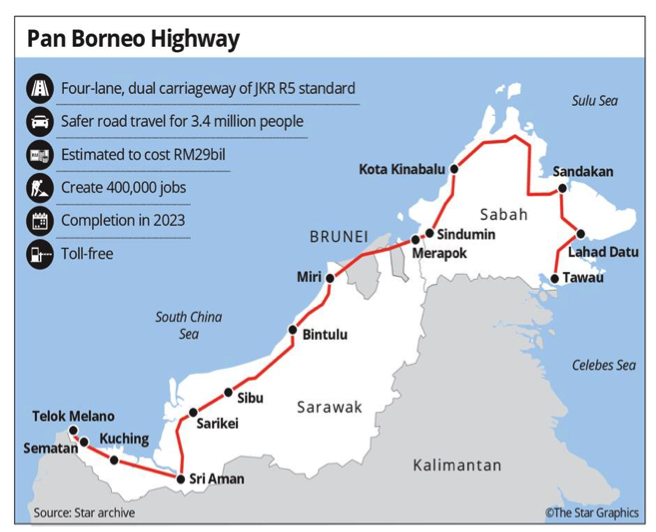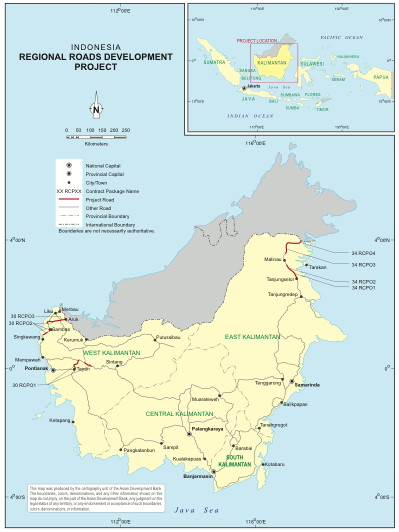“The voice of him that crieth in the wilderness, prepare ye the way of the LORD, make straight in the desert a highway for our God.”
Isaiah 40:3 (KJV)
“Only those who risk going too far can possibly find out how far they can go.”
T.S Eliot
Discover the purpose of your work and your corporation
What Is Your Work’s Purpose?
- Enhancing Connectivity: Your efforts play a crucial role in facilitating the connection of goods, services, populations, businesses, and industries, especially among economically disadvantaged communities in Borneo. You’re building the pathways that unite people and opportunities.
- Setting Standards: Within your sphere of influence, you have the power to establish rigorous standards for due diligence, corporate governance, and transparent transactions. These principles underpin trust and integrity in the business world.
What Drives Your Corporation’s Core Values?
- Fostering Economic Growth and Social Benefits: One of the core values of your corporation is to provide the infrastructure necessary for economic growth and the delivery of social benefits to developing nations. Through the construction and maintenance of highways, you are enabling progress and prosperity in regions that need it most.
- Generating Sustainable Returns: Your corporation is committed to generating long-term, stable yields and reliable returns. It achieves this through toll income, which not only sustains the infrastructure but also provides a reliable source of revenue for continued development and improvement.
- Protecting Against Inflation: Inflation can erode the value of assets over time, but your corporation has a built-in mechanism for protection. By collecting tolls that adjust with inflation, you ensure that your income remains robust, safeguarding both your investments and the communities you serve.
Proposed Trans Borneo Highway
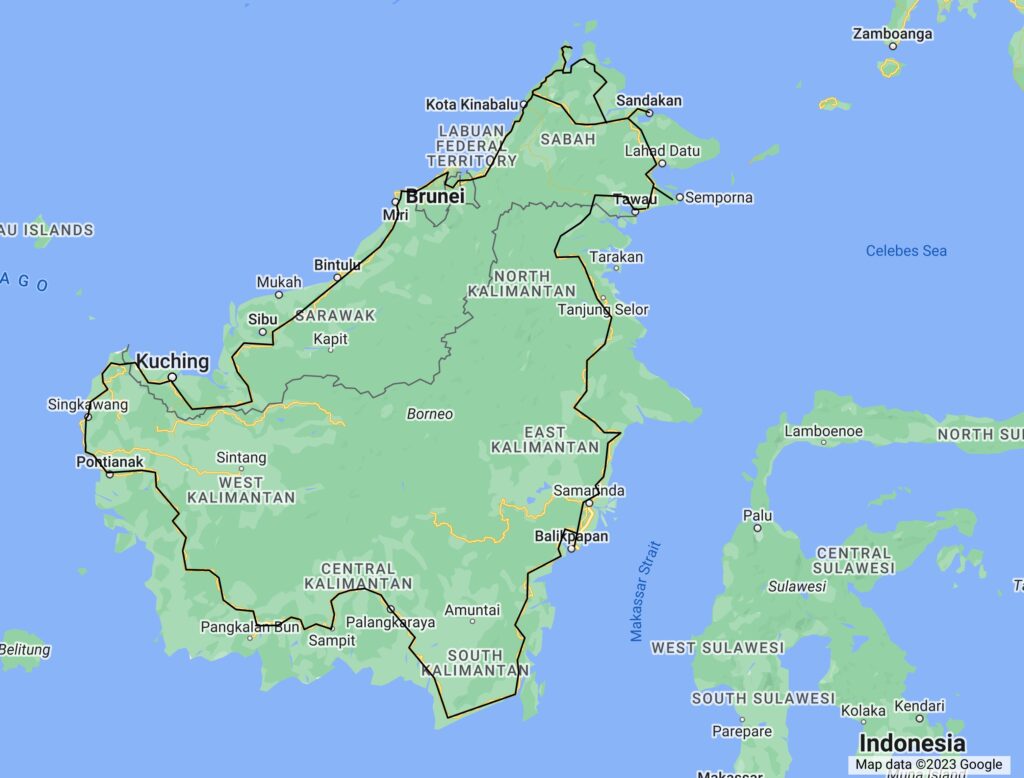
1.0 Executive Summary
Mission
The mission is to create a dynamic public-private partnership (PPP) entity that brings together the expertise and resources of a local government agency, an international infrastructure group, and a foreign financier. This collaborative effort is dedicated to the investment, construction, operation, and eventual transfer of the Trans-Borneo Highway.
Key Management Team
- Mentors: Mentors are visionary pioneers and industry leaders with a vast global network. They provide invaluable guidance and inspiration.
- Coaches: Coaches are mission-oriented industry experts who offer practical solutions to challenges, ensuring the team stays focused on its objectives.
- Partners:
- A project leadership group with experience in the specific segment and international exposure to the toll road industry.
- A reputable investment manager with sources of funding in the Asia Pacific toll road industry.
- Target market groups comprising government agencies.
- A credible local toll road partner with procurement capabilities, local network, sound financial status and solid support from the government.
Product Benefits
- Investor Diversity: Attracting both international and local stakeholders.
- Governance Assurance: Prioritizing diligent corporate governance.
- Transparent Risk Management: Clear strategies for assessing and mitigating risks.
- Profit Sharing: A well-defined structure for cost and profit sharing.
- Long-Term Stability: Providing a consistent, extended yield.
- Reliable Returns: Ensuring dependable income streams.
- Inflation Protection: Safeguarding investments against inflation.
- Connectivity Opportunities: Facilitating economic growth and connectivity.
Target Market
- Phase 1: Kalimantan segment = 4,000 km
- Phase 2:
- Brunei section = 170 km
- Sabah and Sarawak segment = 2,230 km.
Financial Projections
- Investment: US$30.8 billion (Phase 1)
- Cost: US$1.5 billion/year
- Revenue: US$4.5 billion/year
- Income: US$3.0 billion/year
- Concession: 45 Years

Unique Business Model
- PPP: Public-Private Partnership model
- Team: The experienced toll-road group ensures on-time, quality, and financially sound outcomes.
- Growth: Business expansion can include other infrastructure projects in Borneo.
- Support: Local government agencies will provide solid support to the partners.
- Community: Local communities will benefit through on the job training programs.
2.0 Mission
2.1 Problem
Challenge: Borneo lacks foreign investment for a circular coastal highway, hampering economic growth.
2.2 Solution
Solution: Attract foreign investment for highway development.
2.3 Mission
Mission: Form a PPP with local government, international infrastructure experts, and a foreign financier to invest in, build, operate, and transfer the Trans-Borneo Highway:
- Phase 1 Investment: Kalimantan (4,000 km).
- Phase 2 Investment: Brunei (170 km) and Sabah/Sarawak (2,230 km).
Total: 6,400 km of interconnected highway, driving regional and global economic opportunities.
3.0 Product
3.1 Product Description
The Trans-Borneo Highway is AH150 in the Asian Highway network. It connects Brunei, Sabah and Sarawak (Malaysia) and Kalimantan (Indonesia). The toll road will cater for the movement of goods, services and people. Revenue depends on volume turnover and land swap agreement.
3.2 Product Attributes
- Scope: A four-lane dual carriageway with specific design and safety features.
- PPP: Partnerships with international highway experts.
- Financing: Investors have options like tolls and land swaps.
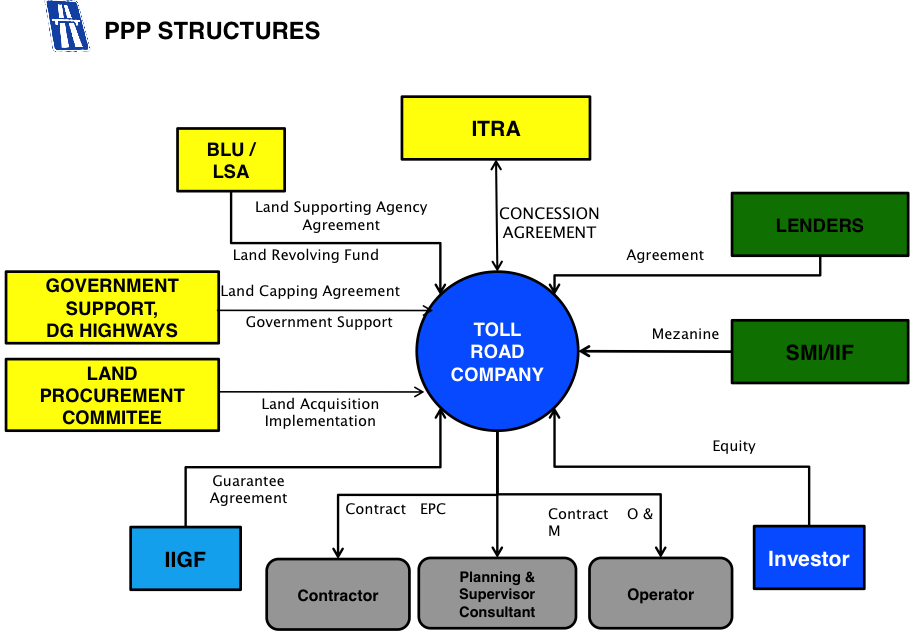
3.3 Product Benefits
- Investors: Attracts diligent international and local stakeholders.
- Share Structure: Transparent risk management and profit-sharing.
- Returns: Long-term stability, reliable income, and inflation protection.
- Connectivity: Boosts connectivity for goods, services, tourism, and more.
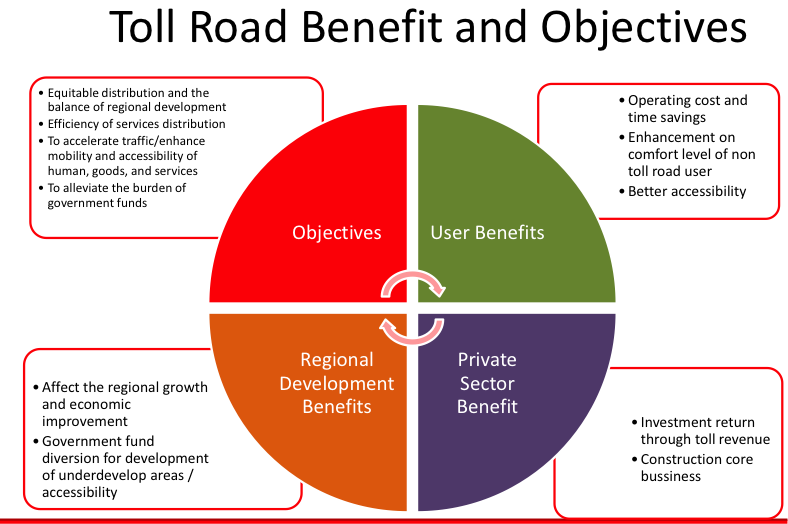
Benefit example: Connectivity for Tourism in Borneo
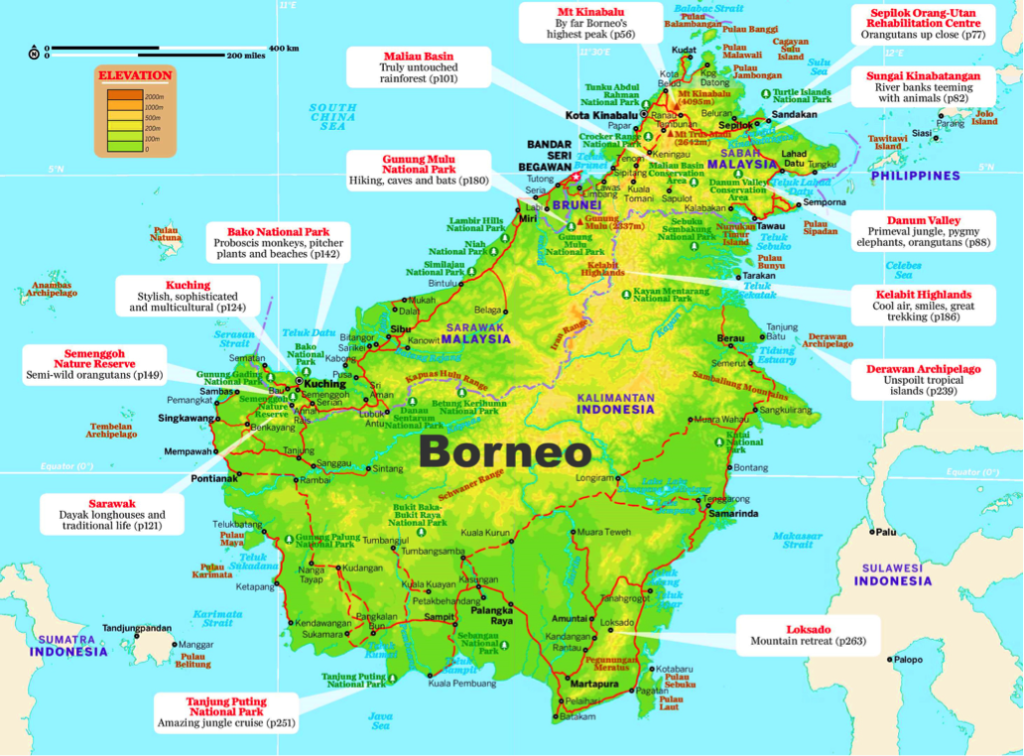
3.4 Product Competitive Advantages
- Expert Team: Led by experienced highway specialists.
- Risk Management: Robust contractual terms ensure time, quality, budget, and returns.
- Ethical Approach: Emphasizes transparency and governance to mitigate corruption and instability risks.
4.0 Market
4.1 Market Segments
Phase 1: Kalimantan (4,000 km) Phase 2: Brunei (170 km) and Sabah/Sarawak (2,230 km) Total: 6,400 km
(*Note: the provincial boundaries depicted in the map have changed since the map was produced in 2011.)
4.2 Target Market Strategy
The target market strategy is focused on the following key areas:
- IBOT (Invest, Build, Operate, Transfer): We will invest in, construct, operate, and eventually transfer the highway at the end of the concession period.
- Toll Charges: Implementing affordable toll charges to ensure a financial return.
- Land-Swap Options: Attracting additional investors in various sectors like agriculture, Special Economic Zones (SEZ), tourism, property, logistics, industrial, and mining industries through land-swap arrangements.
- Quality Upgrades: Implementing a robust program for highway upgrades and regular maintenance.
4.3 Market Needs
Recent market developments indicate:
- Indonesia: The government’s development master plan (2011-2025) includes upgrading 3,316 kilometers of the Trans-Kalimantan Highway, building 1,920 kilometers of new roads in northern Kalimantan near the border of Sarawak and Sabah, and constructing additional highways and expressways across Kalimantan.
- Malaysia: In 2020, the Malaysian Government allocated US$7 billion for the Pan Borneo Highway.
- Brunei: Partnerships with Chinese construction companies for projects such as the Temburong Bridge and Telisai Lumut Highway.
4.4 Growth Drivers
Foreign investors will be driven to invest in toll road projects due to:
- Increasing Demand for Connectivity: The growing need for connectivity between local, regional, and global markets.
- Infrastructure Deficiency: The absence of well-established roads in the region.
- Private Funding Gap: A shortage of private funding for such crucial infrastructure projects.
- Bankability: Enhanced understanding of the financial viability and attractiveness of these projects to stakeholders.
4.5 Key customers
Highway: Pan Borneo Highway
- Kementerian Pembangunan (Ministry of Development) Brunei
- Kementerian Pekerjaan Umum dan Perumahan Rakyat (Ministry of Public Works and Housing), BPJT (Toll Road Authority) Indonesia
- Kementerian Kerja Raya (Minister of Works) Malaysia
4.6 Competitions and Industry
Key players in the tollway industry:
International Players • Abertis • Anhui Expressway • Ashoka Buildcon • ASTM • Atlantia • Atlas Arteria • Autopistas del Sol • Autoroutes Paris-Rhin-Rhone • Autostrade Meridionali • Autostrade Torino-Milano • Bangkok Expressway • Brisa • Companhia de Concessores Rodoviarias • Connecteast Group • Ferrovial • Groupe Eurotunnel • GZI Transport • Hopewell Highway Infrastructure • IRB Infrastructure Developers • Jiangsu Expressway • Macquarie Atlas Roads • NEXCO Central • NEXCO East • NEXCO West • Obrascon Huarte Lain Brazil • OHL Mexico • Road King Infrastructure • Shenzhen Expressway • Sichuan Expressway • Societe Marseillaise du Tunnel Prado • Transurban • Vinci • Zhejiang Expressway
Local key players • ANIH • Hutama Karya • Jasa Marga • Lingkaran Trans Kota • Plus Expressway • Waskita Karya

5.0 Operation
5.1 Toll Road procurement Indonesia
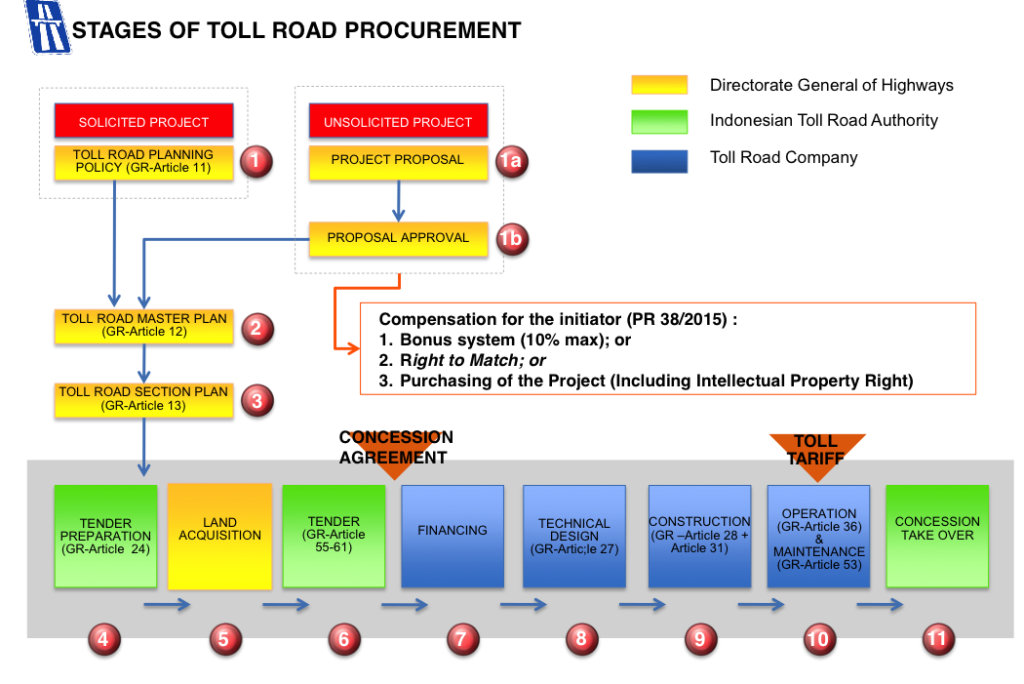
5.2 Toll road BOT stages from the international model

5.3 Toll road life cycle
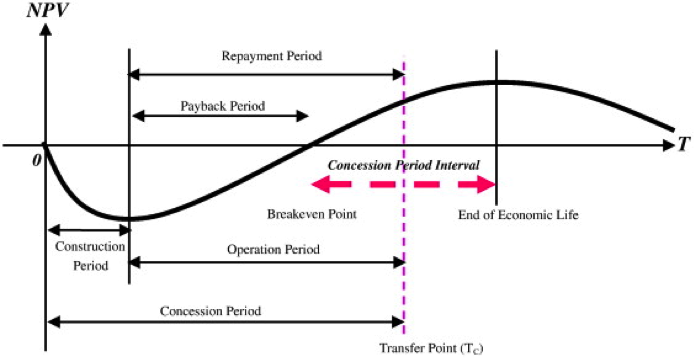
5.4 Process and Timeline
The timeline for the toll road project is as follows:
- Preliminaries: 1 year
- Documentation & Tender: 2 years
- Construction: 12 years
- Operation: 30 years
- Concession Period: 45 years
- Transfer: Occurs at the end of the 46th year.
Estimated process time Indonesia
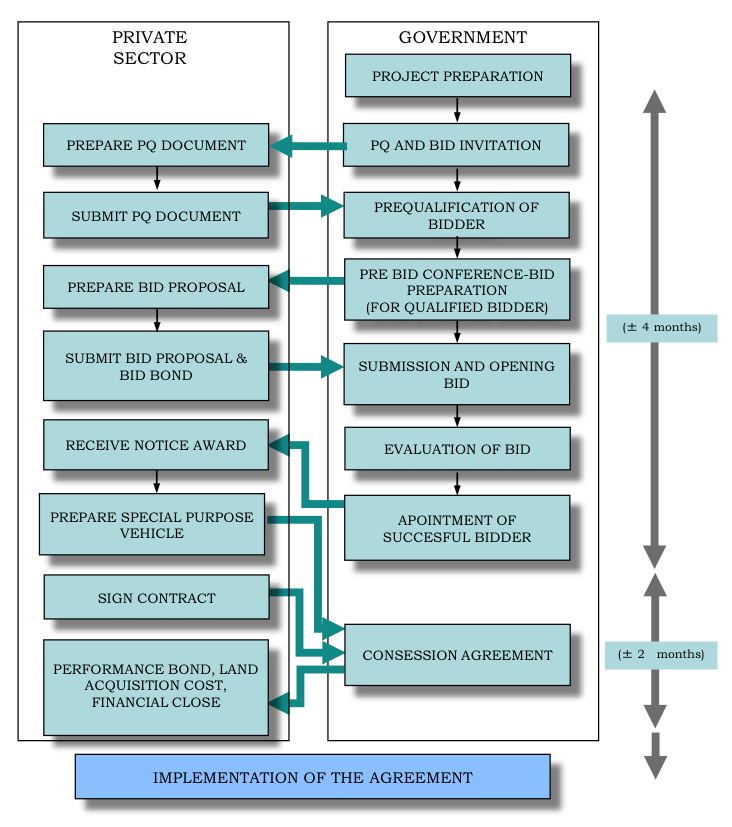
6.0 Financial Implications
6.1 Investment Segments
Highway construction cost in Malaysia = US$4.21 – 5.0 million/km Highway construction cost in Indonesia = US$7.7 – 10.5 million/km • Phase 1 Kalimantan segment: 4,000 km X US$7.7 million/km = US$30.8 billion
6.2 Cost of Production
Admin and maintenance cost in Malaysia = US$0.25 million/km/year
Admin and maintenance cost in Indonesia = US$0.4 million/km/year
• Phase 1 Kalimantan segment:
• Admin and maintenance cost
4,000 km X US$0.4 million/km/y X 1 year = US$1.5 billion/year
6.3 Prices and Revenues
Projected revenues 7.5 million vehicles X 20 km/day X 300 days X US$0.10/km = US$4.5 billion/year
Case Studies: Toll Charges Comparison
- Balikpapan-Samarinda Toll Road (Samboja-Palaran):
- Class 1 Vehicle: US$5.24 (for the entire route)
- Equivalent: US$0.11 per kilometre
- International Comparison Prices (2014-2017):
- Japan: US$0.24 per kilometer
- France: US$0.11 – US$0.13 per kilometer
- Italy: US$0.07 per kilometer
- Spain: US$0.105 per kilometer
6.4 Financial Returns

Cast Studies
Case 1: East Kalimantan Balikpapan – Samarinda 99 km Toll Road (2021)
• Estimated Project Cost: US$767 million
• FIRR: 13.87%
• NPV: US$260 million
• Concession Period: 40 Years
Case 2: Demak-Tuban 197 km Toll Road (2021)
• Estimated Project Cost: US$1,814 million
• FIRR: 11.8%
• NPV: US$351 million
• Concession Period: 50 Years
Case 3: Cikunir-Karawaci Inner City Elevated 40 km Toll Road (2021)
• Estimated Project Cost: US$1,791 million
• FIRR: 12.07%
• NPV: US$220.2 million
• Concession Period: 45 Years
Case 4: Ngawi-Bojonegoro-Babat 119 km Toll Road (2021)
• Estimated Project Cost: US$968 million
• IRR: 11.88%
• NPV: US$179 million
• Concession Period: 50 Years
Case 5: Bogor-Serpong 31 km Toll Road (2021)
• Estimated Project Cost: US$612.9 million
• FIRR: 12.38%
• NPV: US$80 million
• Concession Period: 40 Years
Case 6: Makassar-Maros-Sungguminasa-Takalar 48 km Toll Road (2021)
• Estimated Project Cost: US$508 million
• FIRR: 11.28%
• NPV: US$13.7 million
• Concession Period: 50 Years
Case 7: Malang–Kepanjen 29.8 km Toll Road (2021)
• Estimated Project Cost: US$681.8 million
• IRR: 11.03%
• NPV: US$178.43 million
• Concession Period: 45 Years
Case 8: Banten Serang–Panimbang 51 km Toll Road
• Estimated Project Cost: US$391.6 million
• FIRR: 13.96%
• NPV: US$39.1 million
• Concession Period: 40 Years
Case 9: Cilacap-Yogyakarta 125 km Toll Road (2021)
• Estimated Project Cost: US$1,091 million
• FIRR: 11.88%
• NPV: US$215 million
• Concession Period: 50 Years
Case 10: Kamal-Teluk Naga-Rajeg 38.6 km Toll Road (2021)
• Estimated Project Cost: US$1,286 million
• FIRR: 10.58%
• NPV: US$45 million
• Concession Period: 40 Years
Case 11: South Sentul–West Karawang 61.5 km Toll Road (2021)
• Estimated Project Cost: US$1,066 million
• FIRR: 12.08%
• NPV: US$103 million
• Concession Period: 40 Years
Case 12: Industry Expectation (Emerging Markets)
• Expected IRR: 14-20% for infrastructure projects.
2019 Financial Income of listed infrastructure construction companies.
Global
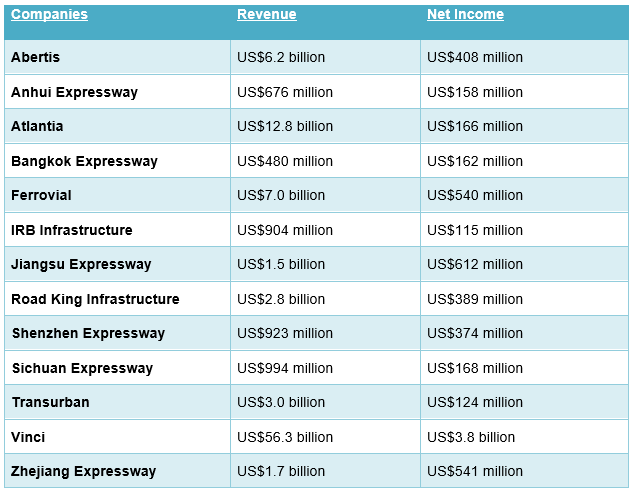
Local

6.5 Source of Funding
1. Strategic Investors
New Investor: A project leader with a strong focus on business and financial management. Financier: Private equity firms and investor groups specialising in tollway projects. Tollway Group: Collaboration with international tollway operator groups. Target Market: Seeking financial support from government agencies in Brunei, Kalimantan, Sabah, and Sarawak.
2. Private Equities and Investors
• 4D Infrastructure • Actis • Allianz Capital Partners • Amber Infrastructure Group • AMP Capital • Amundi Asset Management • Antin Infrastructure Partners • Ardian • Argo Finanziaria • Astatine Investment Partners • Australian Foundation Investment • Azimut Capital Management • BlackRock • Blackstone • Brookfield Infrastructure Group • CDPQ • CI Global Asset Management • Charles Schwab Investment Management • ClearBridge Investments • Cohen & Steers Capital Management • Deutsche Asset Management • Dimensional Fund Advisors • DJE Kapital • DWS Investment • Essence Fund • Ferrovial • Fidelity Management & Research • First Sentier Investors • First State Investments • GIC • Goldman Sachs • Handelsbanken Fonder • Hastings Funds Management • IFM Investors • JP Morgan Asset Management • KKR • Kinetics Asset Management • Krungsri Asset Management • Kuwait Investment Authority (Investment Management) • Lazard Asset Management • Legal & General Investment Management • LSV Asset Management • Lyxor International Asset Management • Macquarie Infrastructure & Real Assets • Magellan Asset Management • Mandiri Manajer Investasi • Manulife Infrastructure Equity Fund • Matthews International Capital Management • MEAG • BNY Mellon Investments • Mercer Global Investments • Meridiam Infrastructure • MetLife Investment Management • Mhaiskar Ventures • Newton Investment Management • Nordea Investment Management • Norges Bank Investment Management • NOVA Infrastructure • Pacific Asset Management • Pantheon Infrastructure • Pinnacle Associates • Plenary Group • Prusik Investment Management • Qatar Holding • Robeco Institutional Asset Management • Santander Asset Management • Schroder Investment Management • SSgA Funds Management • State Street Global Advisors • TCI Fund Management • Threadmark • Thrivent Asset Management • TIAA-CREF Investment Management • TMB Asset Management • TOBAM • T. Rowe Price • UBS Asset Management • Union Investment • Vanguard Group • Yielco Investments
3. Consultants, Development and Funding Managers for the Infrastructure Industries:
• ASECAP • Asian Development Bank (ADB) • Asian Infrastructure Investment Bank (AIIB) • Badan Pengatur Jalan Tol (Indonesia Toll Road Authority) • BCG • China’s Belt and Road Initiative (BRI) • Deloitte • DINFRA • Ernst & Young • IBTTA • Indonesia Infrastructure Finance (IIF) • IIGF • Infrastructure Asia • International Development Finance Corporation (IDFC) • Japan’s Partnership for Quality Infrastructure (PQI) • KPMG • McKinsey • PINA • PPIAF • PWC • RBconsult • RDPT • Sarana Multi Infrastruktur (SMI) • World Bank • Zürcher Kantonalbank (Investment Management)
6.6 Major Revenue Sources
The primary revenue sources for toll roads, including the Trans-Borneo Highway, are:
- Toll Charges: Revenue generated from toll charges paid by vehicles using the highway.
- Land Swap Deals: Investors have the opportunity to develop the land adjacent to the tollway for various purposes, including agriculture plantations, logistic hubs, property development, and special economic zones. This dual-income approach maximizes revenue potential and promotes economic growth in the region.
7.0 Management Team
7.1 Key Management Team
- Mentors: Mentors are visionary pioneers and industry leaders with a vast global network. They provide invaluable guidance and inspiration.
- Coaches: Coaches are mission-oriented industry experts who offer practical solutions to challenges, ensuring the team stays focused on its objectives.
- Partners:
- A project leadership group with experience in the specific segment and international exposure to the toll road industry.
- A reputable investment manager with sources of funding in the Asia Pacific toll road industry.
- Target market groups comprising government agencies.
- A credible local toll road partner with procurement capabilities, local network, sound financial status and solid support from the government.
In the tollway industry, several global leaders have made significant contributions, shaping its growth and success. Here is a list of some of these remarkable individuals, honoured for their vision and dedication:
- Professor Robert Bain
- Scott Charlton
- Professor Danang Parikesit
- Subakti Syukur
- Terry Lee-Williams
- Derek Zen Wei Peu
These are just a few of the outstanding professionals and captains of the industry. The readers are encouraged to explore further and conduct their research to learn more about the management teams in this dynamic field.
7.2 Key Management Team Model
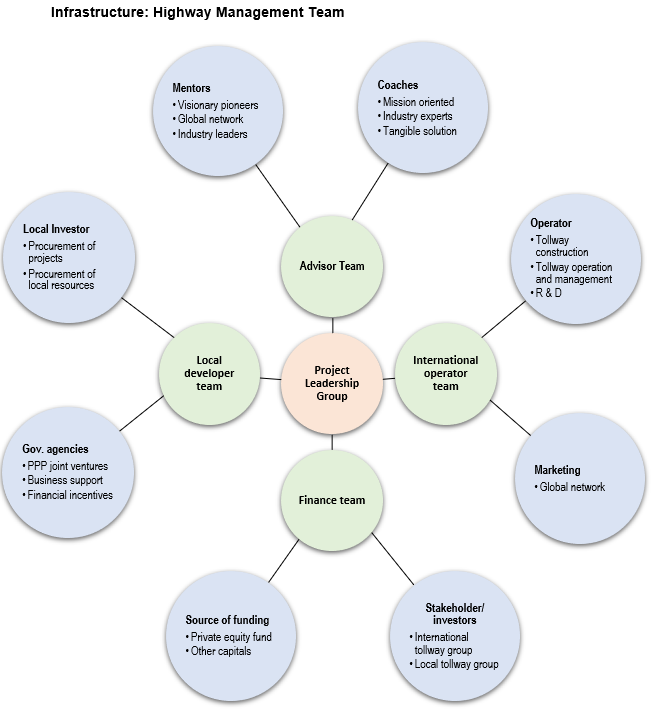
8.0 Unique Business Model
8.1 Successful Track Record
- Team: The team consists of highly successful international key players in the toll road industry, ensuring expertise and experience.
- PPP: The Public-Private Partnership (PPP) model has a proven track record in international toll road projects.
8.2 Entry Model
- Entity: Form a joint venture entity involving international consortiums, local toll road operators, and government agencies for the project’s successful execution.
8.3 Unique Business Model Benefits
The PPP entity and strategic partnership with a government agency offer several key advantages:
- Full Governmental Support: Strong backing from government agencies ensures project stability and support.
- Guaranteed Financial Returns: The partnership assures financial returns, enhancing investor confidence.
- Community Support: Local communities benefit from employment and development opportunities.
- Exposure to Global Funding Network: Access to a global funding network enhances financial capabilities, ensuring project success.
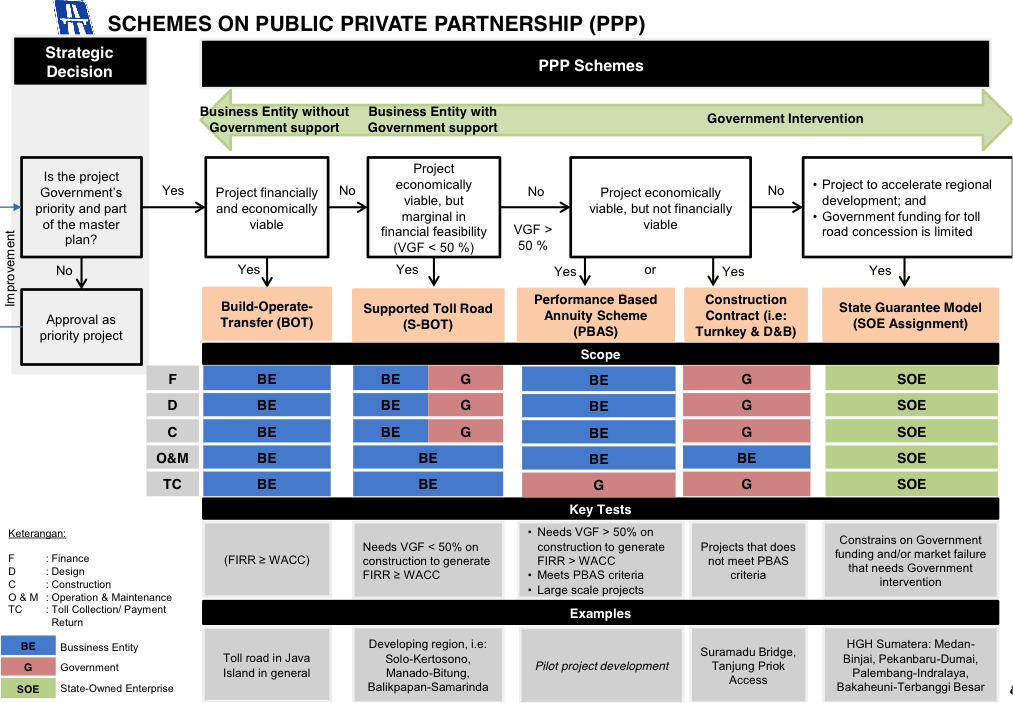
9.0 Key Success Factors & Risk Mitigation
9.1 Key Success Factors
- Team: A robust team with a demonstrated track record of success in the industry.
- Goals: Strong commitment to ensuring secure funding, high-quality project delivery, and favourable financial returns.
- Hands-on: Early involvement in pre-planning, funding sourcing, procurement, and operational aspects to ensure project success.
9.2 Risk
- Political: Potential instability and changes in regulatory policies.
- Continuity: A lack of project continuity may discourage foreign investors seeking stable growth.
- Productivity: Risks related to productivity, performance, and cost overruns.
9.3 Risk Mitigation
- Bankability: Government policies will be established to reinforce the project’s bankability, providing confidence to investors.
- Partnership: Collaborative procurement approaches will offer certainty in financial viability and ensure high-quality performance.
- Competitive: Emphasis on Environmental, Social, and Governance (ESG) factors, competency training, and digitalization will enhance corporate governance, improve technical performance, and guarantee financial returns. These measures will mitigate risks related to productivity and performance.
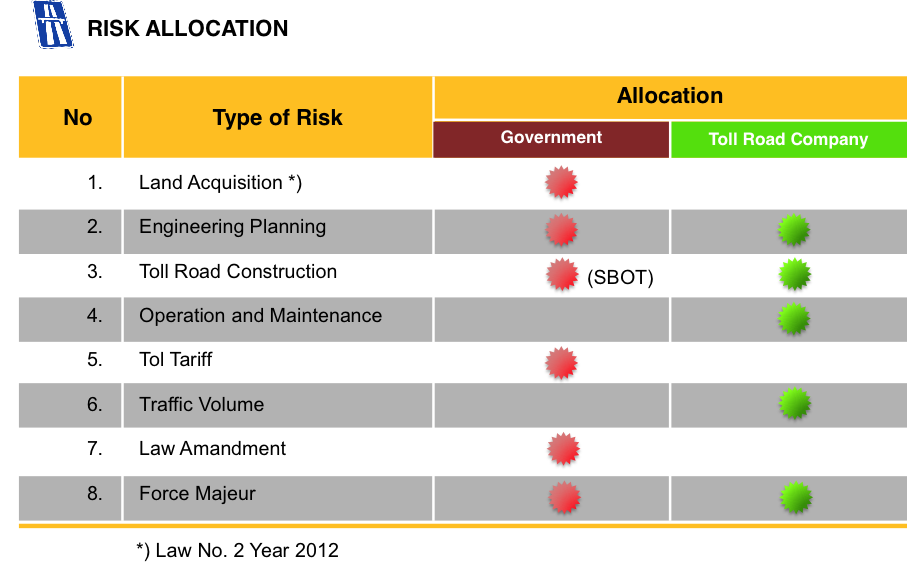
10.0 Exit Strategy
10.1 Forms of Exit
- IPO: Taking the Trans-Borneo Highway project public through an initial public offering.
- Buy-Out: Selling the project to interested buyers.
- M & A: Exploring merger and acquisition opportunities.
- Transfer: Transferring ownership or operational control as per the project agreement.
10.2 Key Attractions for New Investors
- Portfolio Stability: The tollway project serves as a stable, long-term investment.
- Lower Volatility: Limited exposure to short-term market sentiment translates to lower volatility.
- Predictable Cash Flows: Investors can expect timely and predictable cash flows.
- Essential Service: The tollway provides an essential service with limited competition.
- Inflation Adjustments: Concession agreements allow adjustments to inflation rates.
- High Entry Barriers: The project’s high cost and complexity create significant entry barriers for competitors.
- Cost Consolidation: Acquisition opportunities enable cost consolidation.
- Long Life Cycle: The tollway boasts a long life cycle.
- Finance Tolerance: Financial providers are receptive to gearing due to the stable, long-term revenue generated.
